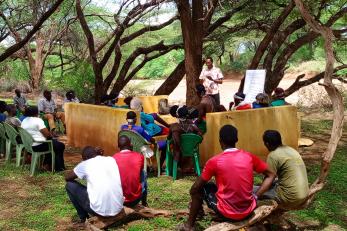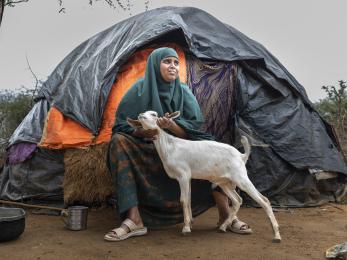Enabling Adaptation
Harnessing the Power of Participatory Approaches to Facilitate Locally Led Climate Adaptation in Northern Kenya

Locally led adaptation (LLA) is increasingly recognized as a critical pathway to building climate resilience by shifting power and resources to local institutions. Despite growing global attention, there remains a significant evidence gap around how to advance the core principles of LLA in practice, in particular, how to design and implement programming and policies that invest in the local institutions that are at the center of LLA efforts. Mercy Corps conducted participatory research in Northern Kenya – where governance dynamics are complex and climate shocks are recurrent – to understand how communities are already responding to climate challenges and what factors support or constrain their efforts.
The study was carried out between September 2024 and March 2025 in three wards in Northern Kenya: Chari (Isiolo County), Waso (Samburu County), and Laisamis (Marsabit County). It engaged community researchers, local government officials, civil society organizations, and the staff and partners of the Mercy Corps RANGE program (which is funded by the Dutch Ministry of Foreign Affairs) to explore how participatory approaches can strengthen climate adaptation.
Through focus group discussions, systems mapping, and community validation sessions, communities identified increasingly unpredictable, prolonged, and intense drought as the core climate challenge shaping their lives and livelihoods. Findings show that communities are actively implementing four locally led adaptations in response to changing patterns of drought:
- Rangeland management through grazing plans, bylaws, and invasive species control
- Conflict management through peace committees, dialogues, and informal patrols
- Herd management through destocking/restocking, livestock health interventions, and drought-resistant breeds
- Livelihood diversification through kitchen gardening, gum/resin harvesting, and small businesses
These efforts are constrained by a combination of interrelated barriers, including poor infrastructure, exclusive governance practices, and economic hardship. Five categories of enablers are critical to overcoming these barriers and unlocking the potential of locally led adaptations:
- Coordination and Relationships: Community governance structures and linkages to formal institutions and markets facilitate collective action and service delivery. Relationships between individuals and norms of reciprocity serve as powerful sources of informal social protection.
- Skills and Capacities: Technical training, mentorship, and financial literacy empower individuals and governance bodies to implement and sustain adaptations.
- Information and Data: Climate forecasts, indigenous knowledge, and context analysis support timely and locally relevant decision-making.
- Resources and Infrastructure: Public infrastructure (roads, water systems, communications) and material assets (seeds, livestock, equipment) are essential for adaptation implementation.
- Principles and Norms: Participation, inclusion, transparency, and equity underpin effective governance and ensure that adaptations reflect community priorities.
The research also demonstrates that participatory methods can help to advance LLA by catalyzing inclusive problem analysis, building trust, and supporting coordinated action planning.
From these findings, governments, donors, civil society, and implementing partners should consider the following recommendations for future efforts to advance locally led climate adaptions in Northern Kenya and beyond:
- Sequence and Layer Participation Thoughtfully: Define the full range of ‘local’ stakeholders and identify opportunities to increase meaningful participation across planning and implementation cycles.
- Empower Communities to Define Climate Challenges: Use participatory tools to enable communities to prioritize climate risks and contribute local knowledge to problem analysis and adaptation planning.
- Identify and Strengthen Locally Led Adaptations: Focus on existing and latent community-led strategies and the types of participation and collaboration that help overcome barriers to their success.
- Integrate Participatory Research into Climate Programming: Embed participatory research and monitoring methods throughout program cycles to simultaneously meet evidence needs and model inclusive, accountable decision-making.
This report is published through the Supporting Pastoralism and Agriculture in Recurrent and Protracted Crises (SPARC) program, which is supported by the United Kingdom’s Foreign, Commonwealth and Development Office (FCDO).

